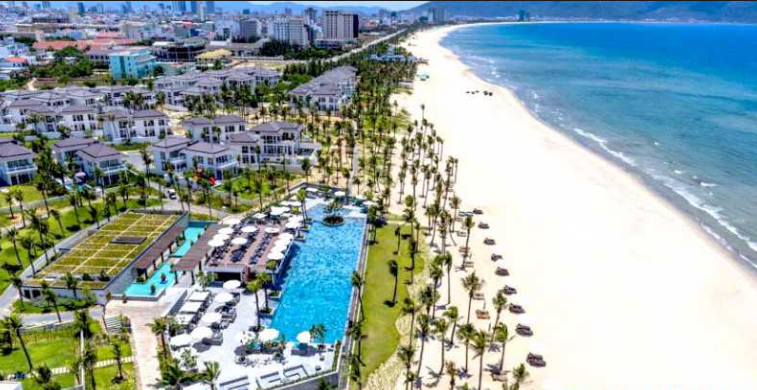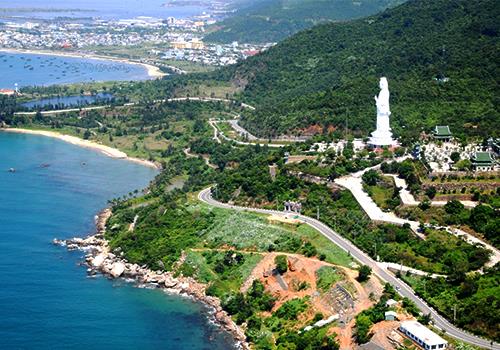City Centre / Downtown Da Nang

The Downtown / City Centre area of Hai Chau District is the area between the Han River and the airport. This is the business and administrative area of the city, and it feels like a normal city compared to the beach. It’s where the best street food and restaurants are, and more variety of clubs and bars.
To make your trip more interesting, stay as close as possible to the river between the Han River Bridge and the Dragon Bridge. Don’t bother staying on the other side of the river if it’s your first time in Da Nang.
The Han Market (Cho Han) is the central point of action along the riverfront. Near the market are travel agents for long distance bus tickets, trains, and tours. The riverfront north of the Han River Bridge is also good if you prefer name-brand luxury hotels.
Beachside / My Khe Beach

It’s on the beachfront you’ll get a glimpse of where future Da Nang is heading. It’s been on the ascent for years, but you could say it made the big time when it made the New York Times list of 52 Places To Go In 2019, where it was described as the “Miami of Vietnam”. That may seem like an incredulous statement, but when you see the emerging skyline on Vo Nguyen Giap (the beachfront boulevard) the comparison makes sense.
The beach starts at the Son Tra Peninsula and goes all the way down to Hoi An. Eventually this beach will be lined with resorts, which is evident as you drive down the coast with all the construction going on. Who knows, maybe in the future people will refer to Miami as the Da Nang of America.
My Khe Beach stretches from the Son Tra Peninsula to the Marble Mountains, forming the seaside boundary of Son Tra District. It’s a long and wide stretch of soft, sandy beach that is regularly listed on “best beaches in the world” listicles. Once you walk along here it’s easy to see why it’s becoming such a popular tourism destination. Da Nang has now become a major destination for South Koreans and Chinese, which makes sense when you consider that it’s the closest big tropical city with a beach. Increasingly, Australians are discovering Da Nang, and I suspect it will only be a matter of time before the first direct Jetstar flights from Australia will arrive.
During the war the biggest US base was in Da Nang, and the beach was a recreational area for US troops where it was known as China Beach. That was the American name, and there was a TV show in the late eighties that kept the name alive. Given the sensitivity of current land and sea disputes between China and Vietnam, you would do well to not refer to it as China Beach (as I have seen it described by some blogs). The government even threatened to close Vietnamese sites that use the name.
In the 1990’s when when the country was opening up again, the beach was a popular backpacker area with cheap guesthouses by the seafront. When I first visited, half of the beach front was empty lots or had temporary seafood restaurants on land waiting to be developed. Those days have long gone as the beachfront is now more resembling the Gold Coast in Australia.
As for where to stay on the beachside, anywhere along Vo Nguyen Giap has good beaches. The northern section of the beach road is Hoang Sa, and along here is the Man Thai fishing village. It’s still a working fishing area, so it comes with the smells that go with it.
The Resort Coast

The resort coast (as I call it) is the section of beach where the beach road of Vo Nguyen Giap goes inland and the big resorts get the beachfront instead. This section of the beach is in Ngu Hanh Son District, the southern district of Da Nang. It includes My An Ward at the top and continues down until it reaches Quang Nam Province, which begins the Hoi An section of the beach.
The beach from Son Tra in Da Nang to Cua Dai in Hoi An is about 28km in length. At the current rate of development the whole coastline down to Hoi An will be a continuous stretch of hotels, and it may be referred to as Greater Da Nang. For the purpose of this guide I’ll keep everything in Da Nang and do a separate post for Hoi An.
The “resort coast” starts from Premier Village Danang Resort in the north, down to Cocobay Resort at the southern border of Da Nang. Midway down this section is the Marble Mountains. South of the Marble Mountains the beach continues as Non Nuoc Beach.
If you are familiar these kind of resorts you will know they are vast properties and not really walkable to local amenities. I would recommend staying along here if you have an allegiance to a hotel brand, or you specifically want a luxury resort holiday and aren’t concerned about having easy access to urban life beyond the resort perimeter.
Son Tra Peninsula

The Son Tra Peninsula is the green headland that marks the northern end of the beach. Its most visible landmark is the Lady Buddha statue, which can be seen halfway down the coast. There were plans to develop the peninsula, but so far it remains as a conservation area. Hopefully it stays that way. If you want to stay here there are two resorts to choose from, and like the resort coast it’s best for those wanting luxurious seclusion rather than experiencing life in Da Nang.


